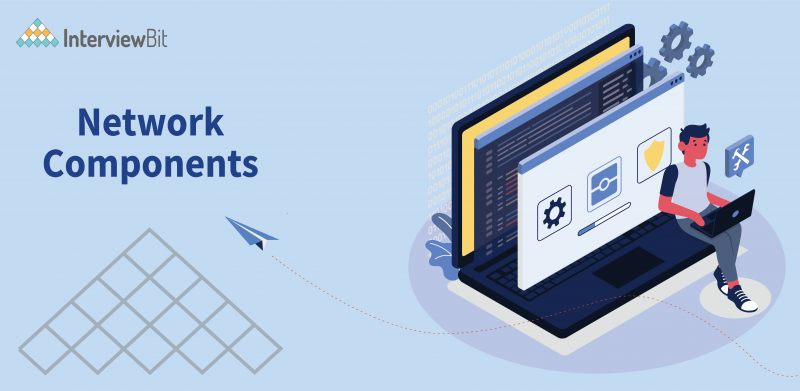Introduction
Components of a Computer Network are said to be the physical devices, software, mediums, etc that together are needed for successfully building the connection between the computing devices.
Before understanding the components of a computer network, Let’s first understand what a computer network is.
Computer Network – Itis the interconnection of two or more computing devices for communication with each other and the exchange of data. These computing devices can be, IoT Devices, Smartphones, Tablets, Laptops, etc, and how these are connected is with the help of some medium like wireless or wired.
In terms of software, the applications we are using on our day-to-day basis like Browser, WhatsApp, Email, etc are all the software that is using computer networks in the background to exchange data with other computers. Hardware + Software both work together to make a successful communication between computers and forms a computer network.
Confused about your next job?
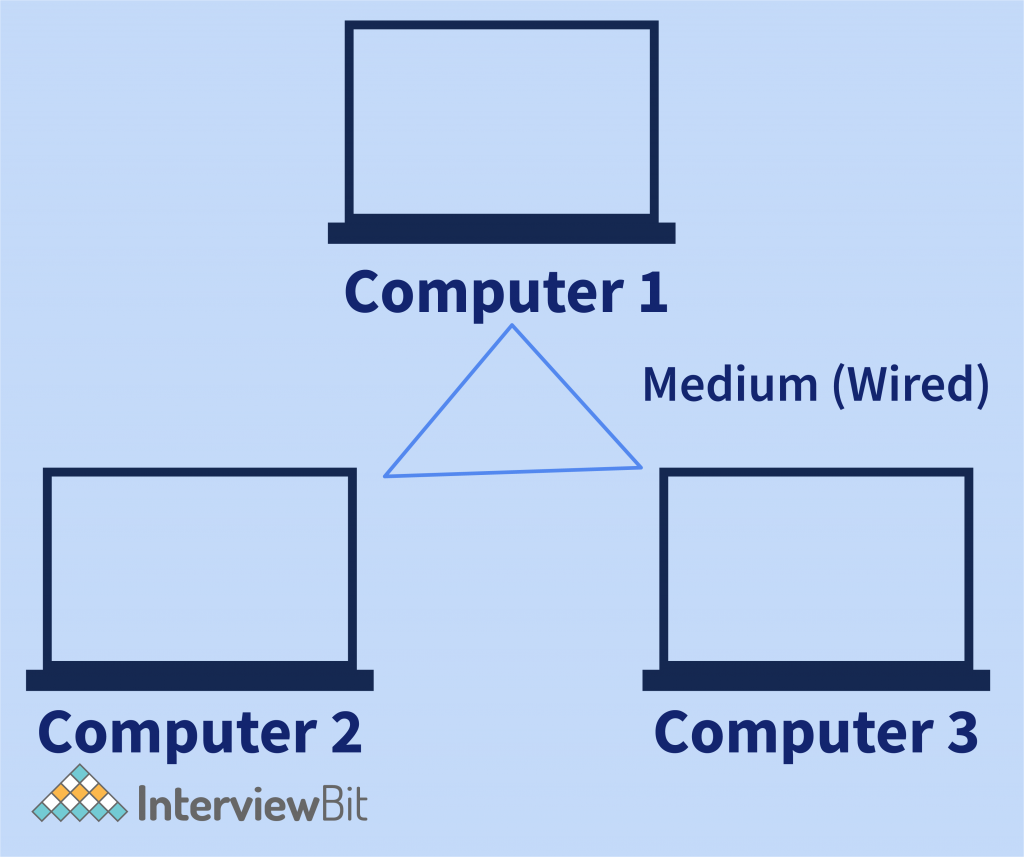
Example – In today’s world, the internet has become so popular. It becomes very essential for communication. So, INTERNET (International Network) is nothing but the large scales of computing devices that are connected to exchange data between each other. This can be the best example of a computer network.
There is a term called Network and Networking –
The Network is the connection of computing devices that are connected through a medium to exchange data.
Networking we can call it as when there is communication happening between the networking devices using the set of protocols.
Components of Computer Network
Components of a computer network are the parts (hardware devices, software, or medium) of computing devices that help to form a computer network. There are 3 different components of a computer network –
- Node
- Media
- Services
These are further categorized into the different individual components that we will see next in this article. Firstly let’s understand the basics of these 3 components –
- A Node can be a computer, printer, or any other device that is capable of sending and receiving the data generated by other nodes in the network. Example – Computers, Routers, Hub/Switches, etc.
- A Media is a transmission medium that connects different nodes and helps to carry the data send from one node to another in the network. Example – WiredorWireless.
- Services are activities that can be implemented with the help of a computer network. Example – Web Surfing, Email, Chat, etc.
To build a computer network these are the superset of the basic components. And these are related to the Hardware. And using this the computer network can build. Now after building the connection, resource sharing can happen efficiently using the software components that we call protocols.
So the term Protocols is nothing but the set of rules that every node in the network has to agree upon for successful transmission of data.
And in the real world, a computer network has a bunch of protocols that are followed for transferring the data in the network like the TCP/IP Model.
These are the basic things related to Computer networks. And now the Components that are involved in the computer network are –
1. Node
Node is the computing device that is connected in order to exchange data over the network. Nodes can be any device that receives and transfers the data over the network for successful communication. Example – Laptop, Smartphone,Routers, etc.Nodes are also categorized into 2 types –
1. End Nodes.
2. Intermediate Nodes.
End Nodes
End nodes are those nodes, which are either the starting point of the communication or the ending point of the communication.If two devices A and B want to communicate with each other, then the device which initiates the connection and the other device that receives the connection is the End Node. These devices communicate with each other using intermediary nodes.
Example – Accessing the internet. So the device from which we are requesting the website is the end node and the server responding with the webpage is the end node.
The End Nodes are –
- Computer – A computer that we use regularly is also the end node. Personal Computers are the originator of the network. It is the original node that requests data and on the other end, the data is being processed by the personal computer.
- Network Printers – The network Printer is also the end node as it processes the printing of the message received from the computer.
- VoIP Phones – (Voice Over Internet Protocol) process the electrical signal into the sound is also the end node. We can call it the latest mobile phone that supports the VoLTE (Voice Over Long term Evolution) service that is used in 4G networks for transmitting the call over the Internet Protocol.
- Telepresence Endpoints – This device is also an end node. And it is mainly used for video conferencing. It is mostly used in meetings in large companies such that the members can join the meeting virtually.
- Security Cameras – It directly deals with capturing the environment and process, so it can also be considered as the end node. These devices are more popular and extensively used in the real world. Like ATMs, Traffics, Hospitals, etc.
- Mobile handheld Devices – Devices like Smartphones, PDA’s, Tablets, Debit / Credit Card Readers, etc are also the end node. These are the regular devices that we typically use. It is also the end node because the request originated from it and the data received are terminated here.
Intermediary Nodes
These nodes act as the mediator for passing the messages or data from one node to another. These are also termed the routing nodes. In other words, we can say that intermediary nodes are nodes placed between end nodes.
Example – If you are accessing a webpage on the internet then your device and server are considered as the end nodes and the routers from which the traffic flows are the intermediary nodes
The Intermediary nodes are –
- Repeaters – It has 2 Ports one for receiving signals and another one for sending signals and it is used to boost the signal strength.
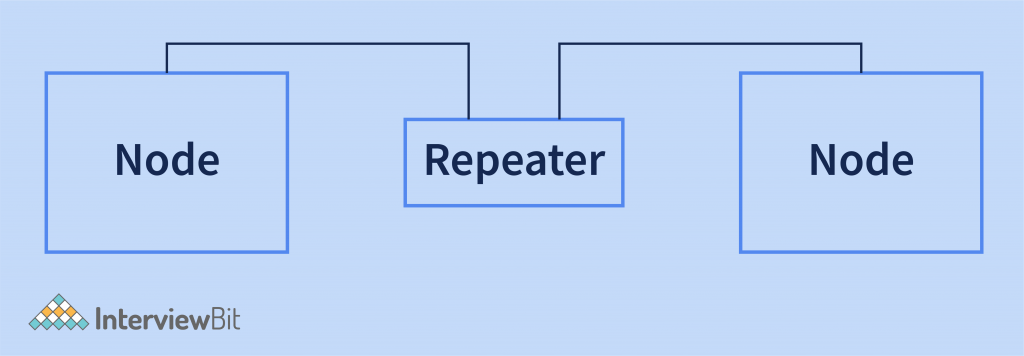
There are 2 different Nodes and the repeater receives the signal from one node and copies the signal with its original frequency and sends it to the next node.
- HUB – It is nothing but the multiport repeater. This exactly behaves like a repeater. But the difference is only that it copies the data it receives from the one port and copies it to all the ports that have connected with it.
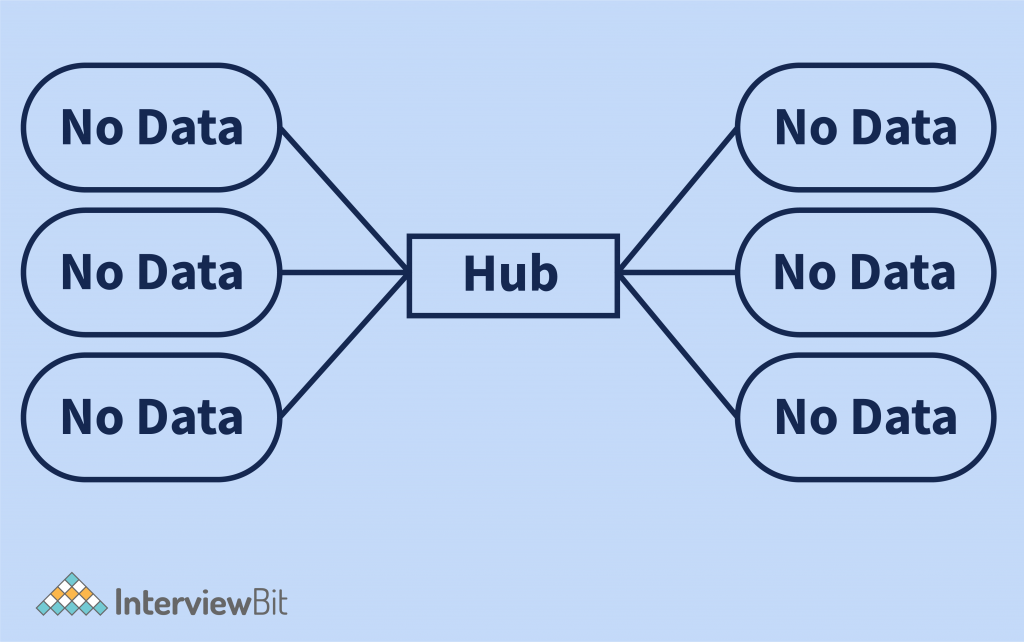
There are two types of HUB –
I. Active Hub – It has its own power supply. And can copy the signal more accurately to the other nodes it is connected with.
II. Passive Hub – It doesn’t have its own power supply so that it cannot repeat the signal, it just relays signals.
- Bridge – It is the intelligent device that can look into the data that it receives in the signal and can identify that the data belongs to which computer. It filters the data based on MAC Addresses. It is a two-port device and it is used to connect 2 LANs (Local Area Network).

There are two types of Bridge –
1. Transparent Bridge – It is the simple bridge that simply transmits the data from one LAN to another.
2. Source-Routing Bridge – It transmits the data reckoning the data packet with which path to be followed so the packet reaches the destination.
- Switch – It is nothing but a multiport bridge. Switches are very smart devices. It has something called Buffer that is nothing but temporary memory. And also have some computing power that comes nowadays
It filters the data based on MAC Addresses and helps to route the packet to reach the destination node.
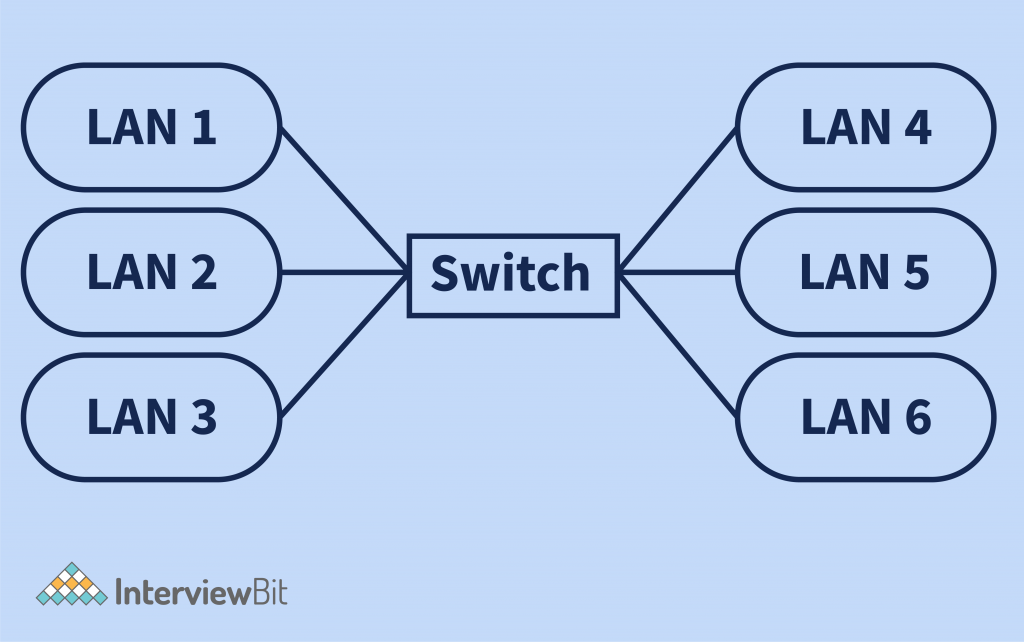
In the above figure, we can see that multiple LANs are connected with the help of a switch, and the packet (data) flows between these are processed by the switch.
- Routers – It is the most intelligent device that is extensively used nowadays. It reads the data about which network location it belongs to. And then transfers the data based on IP Address.
It connects multiple LANs and WANs. That helps these routers to route the packet on the network. It routes the packet to the destination and it achieves this using the help of routing tables. And it contains all the details of nearby routers that help in transmitting the packet so that it can reach the destination.
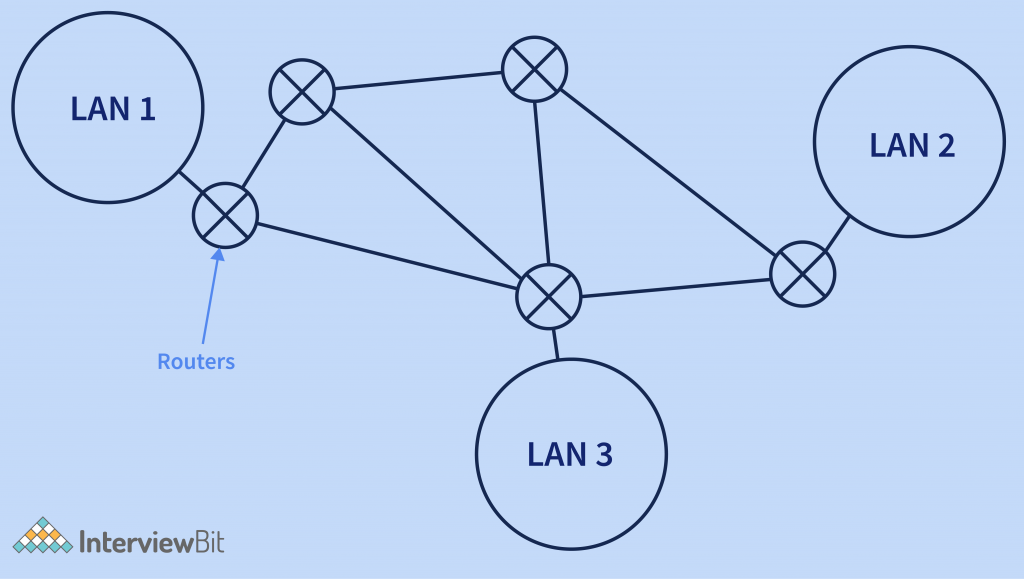
- Brouters – It is the combination of Bridge + Routers. As Routers work on the Network Layer of the TCP/IP model and the bridge works on the Data-Link Layer of the TCP/IP Model. So the brouters work on both of those layers and can perform tasks of both devices.
- Others – There are other intermediary nodes like – Cell Tower, Firewalls (Security devices), Wireless Access Points, etc.
The High-level diagram represents the End-nodes and the intermediary nodes.
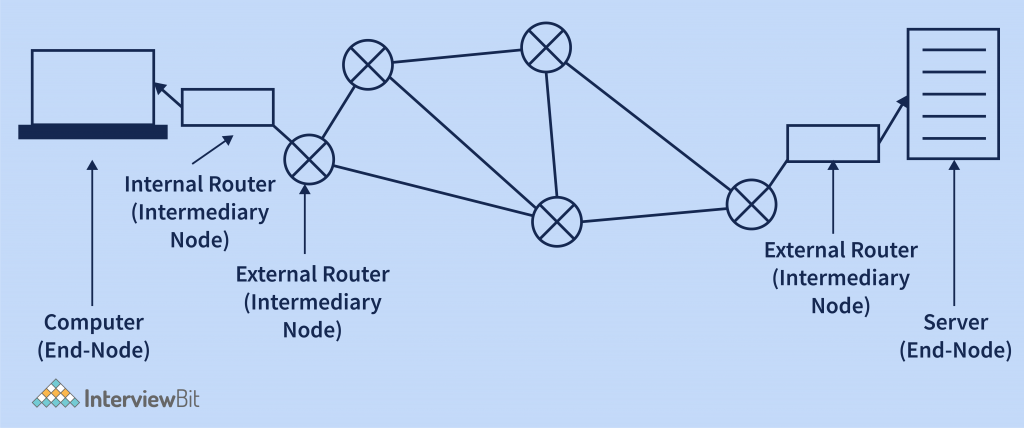
2. Media
It is referred to as the medium through which the signal transmits between nodes. It can also be called the link between nodes. Media is the backbone that enables for connection of the nodes. It is categorized into two different types –
Wired Media
Wireless Media
Wired Media –
It has a physical wire that enables the link between the nodes. It is also called the guided medium. Different types of wired media were used in the transmission of the signals.
- Twisted Pair Cable – It is invented for Telephone lines. And earlier, most computer networks are built on the telephone network themselves and that is done by using the help of Modems. Twisted Pair cables are very thin and cheap and easily breakable. It contains multiple twisted wires in it.
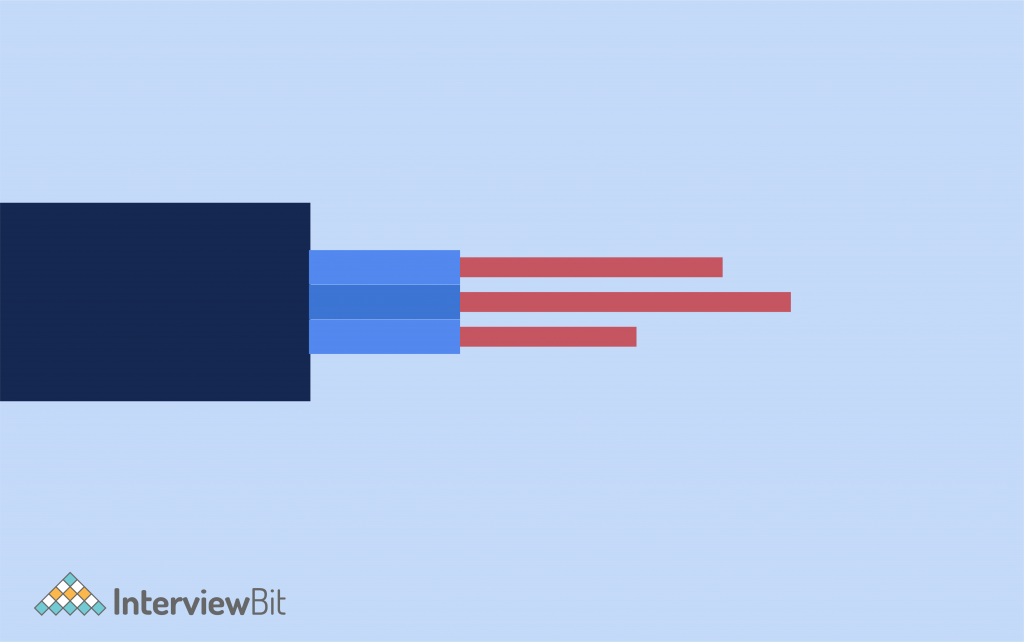
It is mainly meant for small distances. Usually around the distance of fewer than 100 meters.
- Shielded twisted pair cable – It is the enhanced twisted pair cable that was used mainly when transmitting data over telephone lines. The wires that are twisted are shielded with the aluminum shield that helps to avoid loss of data and helps in long-distance data transmission. Although it is also not capable of handling large size data and can’t cover a large distance. It can handle a distance of utmost 100 meters.
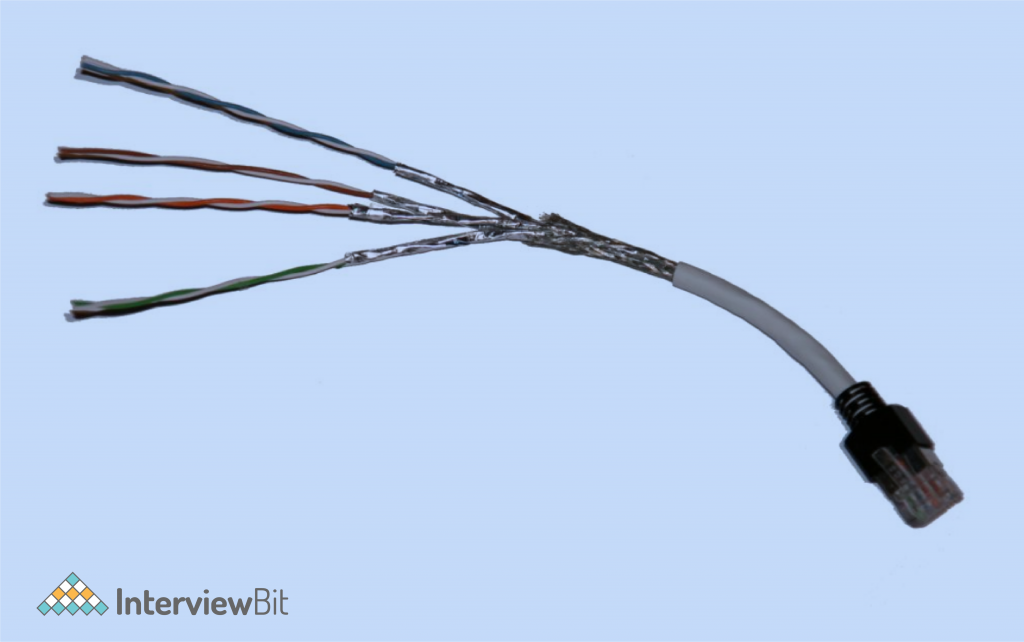
- Coaxial Cable – It has a single wire with a very high capacity. It has a conductor that is wrapped in insulation, which is, in turn, covered with a wire mesh that keeps out electrical noise. Coaxial cable allows carrying many channels simultaneously, which eliminates the need for thousands of separate wires. Most Cable TV companies use coaxial cable to bring many channels of subscription television programming to residences. Coaxial cable is also popular in local networking that the internet service provider is also using for providing internet connections. It is costlier and also can cover a distance of almost 1 Kilo Meter.

- Optical Fiber Cable – Optical Fiber cable or OFC has higher bandwidth and can carry large data. It used the light beam for transferring data from source to destination. This is mostly used nowadays. The internet cables that go to the sea have an optical fiber cable. It has very little magnetic interference. It is very costly and can range from 1 km to 10 km long.
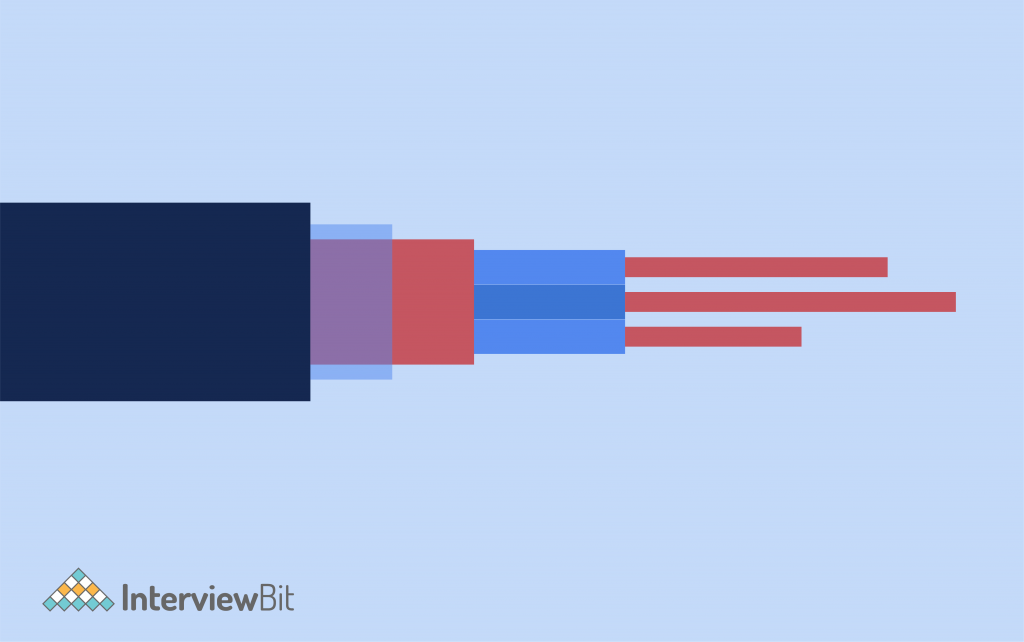
Wireless Media –
In the wireless medium, the data is transmitted without physical wire. We can say that the data is transmitted over the air. It is also called unguided media. Different types of Wireless media that we used are –
- Infrared – It is a type of Electromagnetic signal and is mostly used in Remote systems, Like TV, AC, etc. These cover a short range and the signal will break if any obstacle came in between. Means it can’t penetrate walls. It contains an infrared transmitter and receiver.
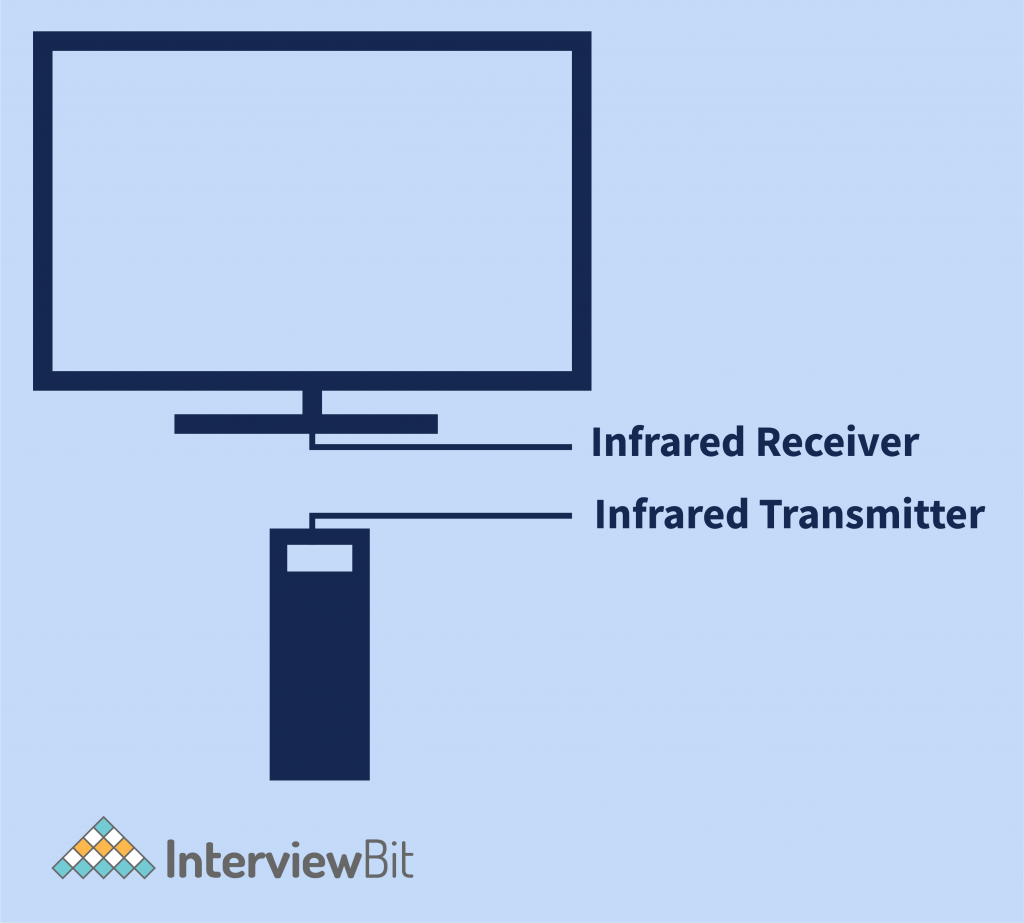
- Microwave (Radio Frequency) – It is also wireless transmission media that is used for transmitting the signals from one node to another node. It uses the radio waves signal for transmission of the signal. It is extensively used in many places like fastag validation. Radio Frequency is also used by mobile towers for their communication. Its range can vary from 10 km up to 100 km depending on the frequency.
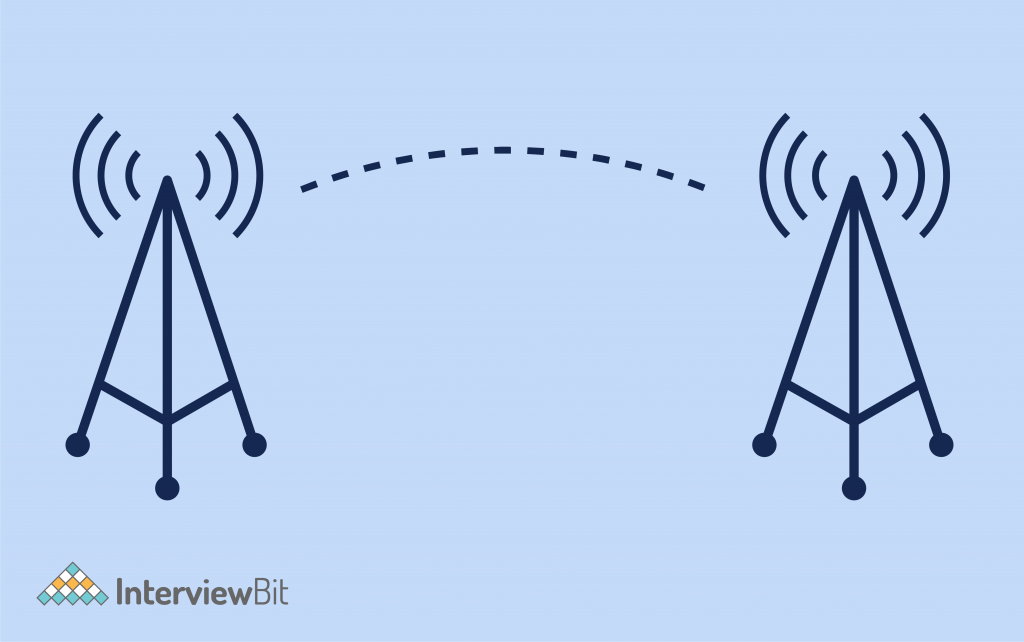
- Radio (WiFi) – WiFi does stand for wireless fidelity. It is mostly used for sharing the internet connection. It also used radio waves in the form of signal that is used for the transmission of data. It is a short-distance communication channel used in a building or campus.
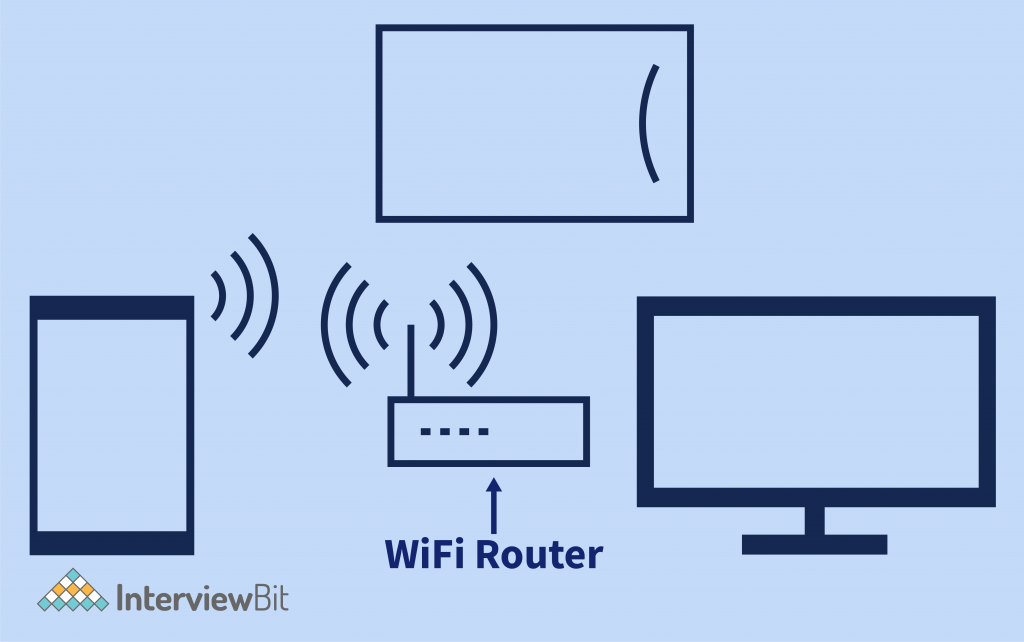
- Satellite – Satellite communication uses artificial satellites to provide communication links between various points on Earth. Satellite communications play a vital role in the global telecommunications system. Satellite communication has two main components – Ground Transmitter and Receiver, and Satellite that is orbiting the earth from space. The communication establishes from the sender to the receiver using the satellite.
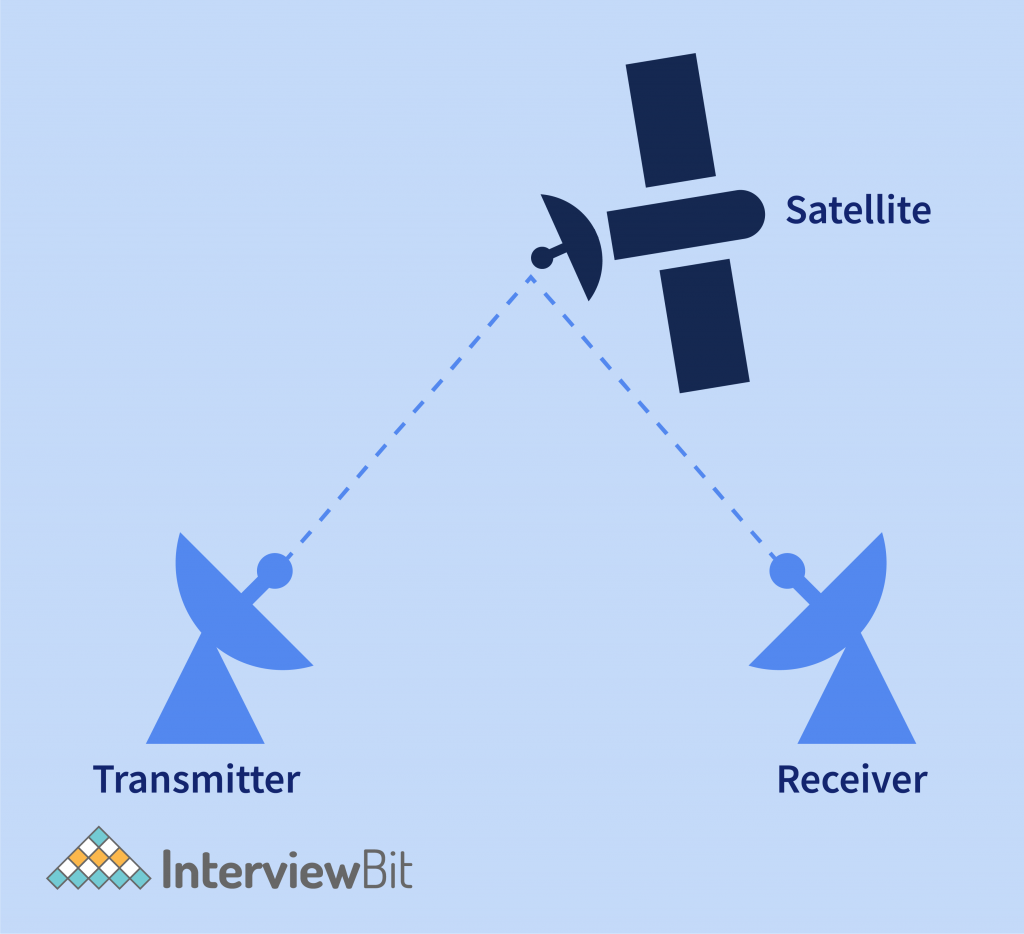
3. Services
Computer networks offer many Services that we use extensively in our daily life. Services Like –
- Storage
- File Sharing
- Instant Messaging
- Online Games
- Video Conferencing
- World Wide Web
- Email – Email (Electronic Mail) is the service that is enabled by the Computer Network. Users can send or receive text messages, attachments, etc things from different users with the help of an EMail Service. Some of the most popular Email service providers are – Gmail (Google Mail), Outlook (Microsoft Mail), Yahoo Mail, etc.
- Storage – Storage is also a service that is enabled with the help of the operating system. We can also call it cloud storage. In this, users are able to store their data online on the platform provided by the companies. Some of the companies that provide cloud storage are – Google Drive, MEGA, OneDrive, etc.
- File-Sharing – Computer network enables file sharing. This can be done using various protocols that are running to enable this.
- Instant Messaging – We often chat using various applications like WhatsApp. Messenger, etc. these are services that are possible with the concept of the computer network.
- Online games – Not every computer system satisfies the hardware requirement of playing games. So online gaming services are also achieved using the concept of computer networks. The game is running on the server-side and the content is delivered to the user using the help of a computer network.
- Video Conferencing – Video conferencing is the most widely used computer network service nowadays. Not only for personal interaction, but for official business meetings also, video conferencing is used. And this is achieved using the concept of the computer network.
- World Wide Web – WWW is also the most widely used service. In today’s world, most things are done using the help of the internet. And the internet (International network) is formed using the Computer Network.
Conclusion
Computer networks in today’s era are the most widely used thing. Mostly everything goes digital and achieving these operations on a computer requires the computer network.
And the backbone of computer networks is the component of the computer network that builds these computer networks. Like routers, media, etc. without this, the computer network cannot be built.







 Join WhatsApp Group
Join WhatsApp Group
